 Music
Music  Music
Music  History
History 10 Less Than Jolly Events That Occurred on December 25
 Weird Stuff
Weird Stuff 10 Funny Ways That Researchers Overthink Christmas
 Politics
Politics 10 Political Scandals That Sent Crowds Into the Streets
 Weird Stuff
Weird Stuff Ten Bizarre Facts About The Doge Meme
 Our World
Our World 10 Ways Your Christmas Tree Is More Lit Than You Think
 Movies and TV
Movies and TV The 10 Coolest Stars to Set Sail on The Love Boat
 History
History 10 Things You Didn’t Know About the American National Anthem
 Technology
Technology Top 10 Everyday Tech Buzzwords That Hide a Darker Past
 Humans
Humans 10 Everyday Human Behaviors That Are Actually Survival Instincts
 Music
Music 10 Surprising Origin Stories of Your Favorite Holiday Songs
 History
History 10 Less Than Jolly Events That Occurred on December 25
 Weird Stuff
Weird Stuff 10 Funny Ways That Researchers Overthink Christmas
Who's Behind Listverse?

Jamie Frater
Head Editor
Jamie founded Listverse due to an insatiable desire to share fascinating, obscure, and bizarre facts. He has been a guest speaker on numerous national radio and television stations and is a five time published author.
More About Us Politics
Politics 10 Political Scandals That Sent Crowds Into the Streets
 Weird Stuff
Weird Stuff Ten Bizarre Facts About The Doge Meme
 Our World
Our World 10 Ways Your Christmas Tree Is More Lit Than You Think
 Movies and TV
Movies and TV The 10 Coolest Stars to Set Sail on The Love Boat
 History
History 10 Things You Didn’t Know About the American National Anthem
 Technology
Technology Top 10 Everyday Tech Buzzwords That Hide a Darker Past
 Humans
Humans 10 Everyday Human Behaviors That Are Actually Survival Instincts
10 Tales Of Oddly Colored People
We have all met people who go a little too heavy on fake tans and end up looking as if they are a well-varnished piece of wood. Makeup blunders make many people look back at their teenage complexions and blush bright red with embarrassment.
But there are other cases of bizarre skin color which have less obvious causes. Here are 10 stories from the history of blue, green, and deathly white people.
10 Carrot Overdose
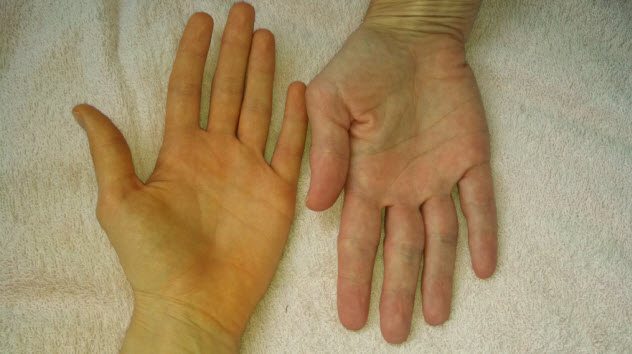
The idea that eating carrots is good for your night vision was created by the British during World War II. Wanting to hide their invention of radar, the British spread the rumor that their pilots were simply eating more carrots and so could see farther. It certainly encouraged an increase in carrot consumption. But it turns out that too much of a good thing can be entirely too much.
Carrots get their color from a group of chemicals known as carotenoids, as do many other fruits and vegetables. Carotenoids are a valuable part of the human diet and contribute to our skin’s ability to avoid sunburn.
But eating too much food with a high carotenoid concentration can cause problems. The chemicals build up in the skin and change the color of it accordingly. Eat too many carrots, and you may find yourself turning orange. As carotenoids are fat soluble, this issue, called carotenemia or carotenosis, shows most clearly in areas where these is a lot of subsurface fat.[1]
Luckily, the solution to this situation is an easy one—stop eating the source of the carotenoids. The color will fade as the carotenoids are naturally removed from the body.
9 The Canary Girls

If it was World War II which created an appetite for carrots, it was World War I which created another class of strangely hued people. With millions of men away at the front, the roles of factory workers were taken over by women. Those working in the munitions factories filling shells with TNT became known as Canary Girls. Not because they sang while they worked, but because the TNT had turned their skin and hair bright yellow.
Doing their patriotic duty cost the Canary Girls more than their looks. The chemicals they worked with could cause rashes, chest problems, and nausea. That is besides the obvious danger of explosions.
They also risked passing on the yellow color they developed. Those women who gave birth while working at the arms factories often found their children were just as lurid as they were.[2] Luckily, as infants were not put to work in the same factories, their color faded with time.
8 Green Children Of Woolpit
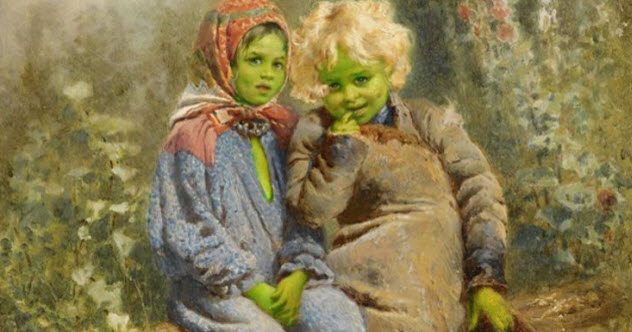
In the 12th century in England, a boy and a girl were discovered by people out harvesting in the village of Woolpit. In itself, this must not have been too unusual at a time when orphans were far more common. But one thing stood out—the children were green.
The villagers had found the children, who did not speak any known language, in the pest-capturing wolf pits that gave the village its name. Taken back to the village, the green children refused to eat anything until fresh beans were set in front of them.[3]
Was their ravenous appetite for green beans the source of their verdant skin? That is just one of the explanations put forward. Others are that the children were suffering from anemia caused by their poor diets.
The boy died, but the girl survived. Her color faded, and she eventually learned English. Able to talk about her past, she described how she and her brother came from the “Land of Saint Martin” where everyone was green and there was no sun.
The two had wandered off, entered a cave, and emerged in our land. Whatever the truth of the story and the true cause of their color, the children of Woolpit have become legendary.
7 The Blue Fugates

Small communities and intermarriage can lead to uniformity in the shallow gene pool. Without the fresh influx of diversity, certain characteristics can become fixed, be it blond hair, freckles, or blue skin. In the Appalachian Mountains, a family called the Fugates had a propensity to strangely blue skin.
French immigrant Martin Fugate had married a local girl in the 1800s. Of their seven children, four were born with blue skin. Through intermarriage and a certain amount of inbreeding, blue-skinned babies became relatively common in the area. Even in the late 20th century, descendants of Martin Fugate were being rushed to the hospital at birth because of their blue color by doctors who had never heard of the blue Fugates.[4]
The cause of the blue hue is a recessive gene which causes methaemoglobinaemia, a condition where the blood is less able to carry oxygen. This makes the blood darker, and the skin appears blue. Thanks to an influx of outsiders bringing other genes to the area, the condition is much less common today.
6 Canthaxanthin

A healthy tan is one of the most important fashion accessories these days. Those without the time and money to get one naturally can turn to tanning beds, tanning lotion, and even tanning pills to acquire one. Tanning pills, not approved in the US, often contain a chemical called canthaxanthin.
Canthaxanthin is closely related to the carotenoids in carrots. Medically, it is used to make the skin less sensitive to sunlight. It is also used in the food industry in animal feed to give a more vibrant color to egg yolks, salmon, and chicken skin. Those desperate for the healthy appearance of chicken skin have turned to canthaxanthin.
When tanning pills are taken, they give massive doses of canthaxanthin, which builds up in the skin. Some people taking canthaxanthin can turn yellowish, orange, or even dark brown.[5]
5 Dermatographic Urticaria
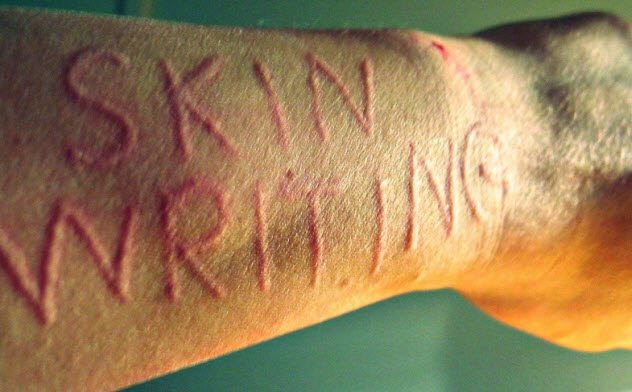
If you rub your skin hard, it will appear pale as the blood is pushed out. But the color soon returns. If it is pushed hard enough, it may turn red. But that will likely fade quickly. Those with dermatographic urticaria can find their skin turning pale, raised, and surrounded by redness at the lightest touch.
Dermatographism (“skin writing”) is just what it sounds like. Sufferers are literally able to write on their skin by simply applying pressure to raise the itchy welts. Some even turn their ability into a form of artistic expression. The raised areas return to normal in about half an hour.
The cause of dermatographism is not entirely understood, but it is thought to be caused by the release of histamines when the skin is slightly damaged by pressure. Most sufferers do not need treatment, but antihistamines help.[6] The other alternative is not to touch anything.
4 Gold Poisoning

Most people want as much gold as they can get. They should be warned that it should generally remain on the outside of the body. The modern fad of decorating food with thin gold leaf is unlikely to cause trouble as metallic gold is generally biologically inert. It passes through the body unchanged. That decorated cake will lead to nothing worse than a glittering bowel movement.
Gold does have medical uses. Some gold compounds are injected into sufferers of rheumatoid arthritis because the compounds help to ease the inflammation which makes the condition so painful.
The kidneys and liver can help to remove much of the gold from the body. But with long exposure, some will be deposited in the skin, causing a condition called chrysiasis.[7]
It starts with discoloration of the eyes, turning them brown or purple. In parts of the body exposed to UV light, the gold particles gather and scatter light. Few people are treated with gold therapy these days. But if you are, you may be left with a permanent blue-gray appearance.
3 Elizabethan Skin Whitening

Tans are in vogue at the moment, perhaps as people try to emulate those who have the leisure time to hone their tans on a beach. In the past, though, a pale glow was considered chic as it suggested that a person was wealthy enough to spend all his time indoors.
To achieve a deathly white appearance, people plastered their faces with makeup. A cosmetic made from white lead was used, with all the inevitable health issues you would expect.[8]
The lead in the makeup ate into the skin and caused it to blacken. This darkening left people applying ever more toxic white lead to cover up the effects of the previous applications.
The effort to appear more beautiful left users with withered skin and rotten teeth. Their hair also fell out. Some have even implicated the use of white lead in the death of Queen Elizabeth I, known for her corpse-like pallor.
2 Sunny Delight
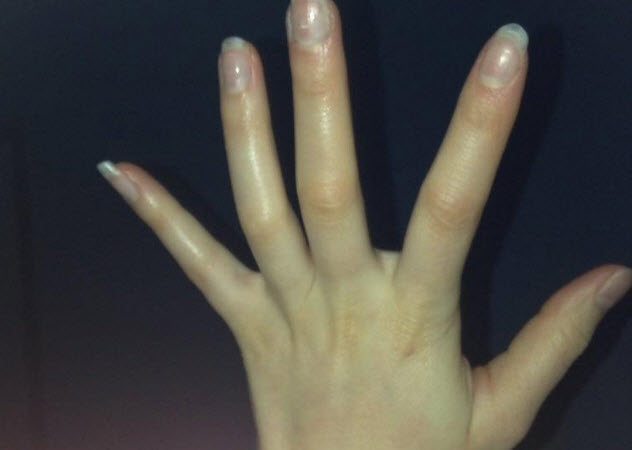
In the late 1990s in Britain, the orange drink Sunny Delight was in vogue and had advertisements everywhere. Its Christmas ad showed a snowman drinking some of the juice and turning yellow as a result. This festive change of color proved ill-timed as a young girl was admitted to the hospital around the same time, having turned just as yellow as the snowman after drinking Sunny Delight.
The parents of the four-year-old girl had allowed her to drink 1.5 liters (6 cups) of Sunny Delight per day.[9] This amount contained enough beta carotene to turn the child yellow, just as other carotenoids are able to do.
There was no lasting harm to the girl, but the brand was damaged by the news story. Despite pointing out that the girl was drinking far too much and that other foods and drinks could have done the same thing, the drink was never again a cultural force.
1 Silver Medicine
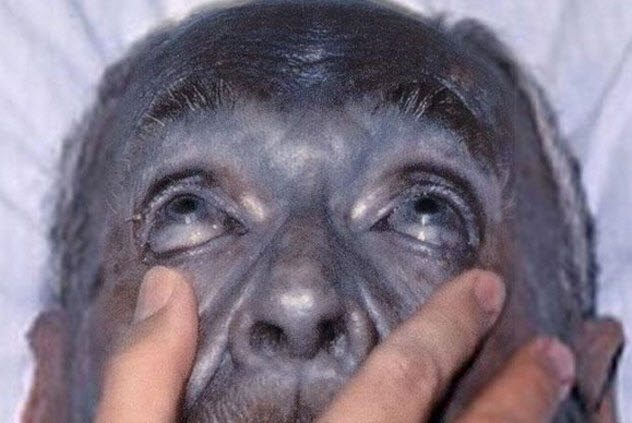
We’ve seen what too much gold can do to the skin, but the gold prize for skin coloring goes to silver. Argyria is a condition in which silver builds up in the skin and eyes, turning them a vivid blue.
Colloidal silver is having something of a renaissance at the moment as an alternative medicine. It is sold as a cure for everything from cancer to AIDS to herpes. Those who do not want to buy a constant supply of the medicine can invest in machines that will impregnate water with silver from the comfort of their own homes.
Paul Karason did just that and drank a glass of colloidal silver every day. Today, he sports a cheery, healthy, and deeply blue face. Stan Jones, a libertarian politician, worried that antibiotics would be scarce in the post-Y2K world and so fortified himself with colloidal silver. His blue visage has not helped him at the ballot box.[10]
Despite the known dangers and permanent change caused by colloidal silver, the substance remains readily available in health food shops and online.
Read more interesting stories about color on 10 Bizarre Ways Color Affects Your Brain and 10 Fascinating Facts About Color.








